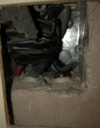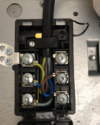Hi,
Hoping someone can help with the following cooker/hob wiring query as I've searched the forum and can't find a definitive answer on whether I can supply multiple appliances from a single cooker circuit without installing an additional consumer unit in the kitchen.
First some background.....
When we bought this house it came with an eye-level double electric oven and a separate electric hob both running off a single radial circuit with a cooker switch (CCU with no socket) above the worktop. The circuit is protected by a 45A MCB on the non-RCD side of the consumer unit. The oven is located two kitchen units away from the hob.
A couple of years ago I replaced the double oven with a newer smaller model that is rated at up to 3950W. I noticed then that the cable supplying the old oven was 10mm2 T+E and I used the same cable for the new oven.
This weekend I upgraded our hob to an induction one with a max power rating of 7400W. The old hob had a flexible 3-core cable that connected to a 4mm2 T+E supply cable via a junction box mounted in the cupboard below the hob. When I installed the new induction hob, I replaced this junction box with Wago connectors and a Wago box.
The new hob came with a flexible cable (see attached photo) that has 5-cores (2xL, 2xN, 1xE) and for a single phase supply you just join the lives and neutrals together at the supply end (as shown at https://www.diynot.com/diy/threads/wiring-up-induction-hob.533200/). It has an external diameter of approx 10mm. I'm assuming this cable is rated at 32A.
Initially the hob refused to power up and (long story short) I discovered that the supply voltage to the hob was only measuring 115V. I then pulled the oven out of its cabinet and found that by waggling the 10mm2 supply cable to the oven I could make the voltage at the hob jump up to 230V or down to zero. Clearly a loose connection or a short somewhere....
So I traced the 4mm hob cable and the 10mm oven cable back to see where they were fed from, expecting to find a cooker plate behind one of the kitchen units. Instead I found a flush mount back box buried in the wall and in that (with no cover on it) a big lump of terminal block wrapped up in insulating tape. See attached photo. The terminal block had a 10mm feed from the CCU going into it and then the 4mm and 10mm cables for the hob and oven. At least one of the terminals was quite loose.
As a temporary solution, I have ripped out the buried 10mm cable to the oven (see attached photo) and replaced it with unburied 2.5mm T+E - which means that (after much swearing) I've been able to get everything to fit securely into the terminal block. But I now want to fix it properly.
My plan is to get a double cooker plate (https://www.tlc-direct.co.uk/Products/AA45DCOP.html) and fit that where the open back box is. This will be fed with the 10mm cable from the CCU. I'll run a 4mm2 T+E cable from the plate to the oven. And the hob will either be wired directly into the cooker plate using the flexible cable that came with it (if long enough) or I'll keep the existing arrangement of using 4mm2 T+E from the cooker plate and joining that to the hob's flex with WAGOs.
So my questions are:
1. If I do the above, is it still ok to use a 45A MCB? I'm thinking not, because the 4mm cables to the hob and oven will only be rated to 37A. And I don't really want to change to a 32A MCB because of (3) below.
2. So I could use 6mm T+E from the cooker plate to the oven and the hob instead. And that makes the 45A MCB ok because 6mm cable is rated at 47A. But what happens about the fact that the flex on the hob (and its internal wiring?) is probably only rated to 32A? Ditto the internal wiring of the oven. Does that matter? I've seen conflicting views on the forum.
3. If at a later date I decide to replace the current double oven with two singles (rated at 3,600W each) I believe that will be fine in terms of total load on the cooker circuit as I'll have hob (7400W) + 2 x cookers (7200W) = 14,600. That's 63.5A at 230V and using the diversity calculation gives 26.05A which is well below the 45A rating of the MCB and the buried 10mm2 supply cable. But how would I wire in the second oven? Does anyone make a 3-way cooker plate?
4. Should I - either now for my one oven and one hob, or at a later date when I upgrade to two ovens and one hob - be looking to use a small 2 or 3 way consumer unit (eg https://www.tlc-direct.co.uk/Products/MKY5704SMET.html) somewhere below the worktop so as I can have individual 32A and 16A MCBs for the hob and oven(s)?
I know one solution would be to install separate radials for the hob and the oven(s) but at the moment I'd very much prefer to keep everything on one circuit, especially as the existing 10mm2 cable is easily capable of supplying everything.
Thanks in advance!
Hoping someone can help with the following cooker/hob wiring query as I've searched the forum and can't find a definitive answer on whether I can supply multiple appliances from a single cooker circuit without installing an additional consumer unit in the kitchen.
First some background.....
When we bought this house it came with an eye-level double electric oven and a separate electric hob both running off a single radial circuit with a cooker switch (CCU with no socket) above the worktop. The circuit is protected by a 45A MCB on the non-RCD side of the consumer unit. The oven is located two kitchen units away from the hob.
A couple of years ago I replaced the double oven with a newer smaller model that is rated at up to 3950W. I noticed then that the cable supplying the old oven was 10mm2 T+E and I used the same cable for the new oven.
This weekend I upgraded our hob to an induction one with a max power rating of 7400W. The old hob had a flexible 3-core cable that connected to a 4mm2 T+E supply cable via a junction box mounted in the cupboard below the hob. When I installed the new induction hob, I replaced this junction box with Wago connectors and a Wago box.
The new hob came with a flexible cable (see attached photo) that has 5-cores (2xL, 2xN, 1xE) and for a single phase supply you just join the lives and neutrals together at the supply end (as shown at https://www.diynot.com/diy/threads/wiring-up-induction-hob.533200/). It has an external diameter of approx 10mm. I'm assuming this cable is rated at 32A.
Initially the hob refused to power up and (long story short) I discovered that the supply voltage to the hob was only measuring 115V. I then pulled the oven out of its cabinet and found that by waggling the 10mm2 supply cable to the oven I could make the voltage at the hob jump up to 230V or down to zero. Clearly a loose connection or a short somewhere....
So I traced the 4mm hob cable and the 10mm oven cable back to see where they were fed from, expecting to find a cooker plate behind one of the kitchen units. Instead I found a flush mount back box buried in the wall and in that (with no cover on it) a big lump of terminal block wrapped up in insulating tape. See attached photo. The terminal block had a 10mm feed from the CCU going into it and then the 4mm and 10mm cables for the hob and oven. At least one of the terminals was quite loose.
As a temporary solution, I have ripped out the buried 10mm cable to the oven (see attached photo) and replaced it with unburied 2.5mm T+E - which means that (after much swearing) I've been able to get everything to fit securely into the terminal block. But I now want to fix it properly.
My plan is to get a double cooker plate (https://www.tlc-direct.co.uk/Products/AA45DCOP.html) and fit that where the open back box is. This will be fed with the 10mm cable from the CCU. I'll run a 4mm2 T+E cable from the plate to the oven. And the hob will either be wired directly into the cooker plate using the flexible cable that came with it (if long enough) or I'll keep the existing arrangement of using 4mm2 T+E from the cooker plate and joining that to the hob's flex with WAGOs.
So my questions are:
1. If I do the above, is it still ok to use a 45A MCB? I'm thinking not, because the 4mm cables to the hob and oven will only be rated to 37A. And I don't really want to change to a 32A MCB because of (3) below.
2. So I could use 6mm T+E from the cooker plate to the oven and the hob instead. And that makes the 45A MCB ok because 6mm cable is rated at 47A. But what happens about the fact that the flex on the hob (and its internal wiring?) is probably only rated to 32A? Ditto the internal wiring of the oven. Does that matter? I've seen conflicting views on the forum.
3. If at a later date I decide to replace the current double oven with two singles (rated at 3,600W each) I believe that will be fine in terms of total load on the cooker circuit as I'll have hob (7400W) + 2 x cookers (7200W) = 14,600. That's 63.5A at 230V and using the diversity calculation gives 26.05A which is well below the 45A rating of the MCB and the buried 10mm2 supply cable. But how would I wire in the second oven? Does anyone make a 3-way cooker plate?
4. Should I - either now for my one oven and one hob, or at a later date when I upgrade to two ovens and one hob - be looking to use a small 2 or 3 way consumer unit (eg https://www.tlc-direct.co.uk/Products/MKY5704SMET.html) somewhere below the worktop so as I can have individual 32A and 16A MCBs for the hob and oven(s)?
I know one solution would be to install separate radials for the hob and the oven(s) but at the moment I'd very much prefer to keep everything on one circuit, especially as the existing 10mm2 cable is easily capable of supplying everything.
Thanks in advance!




